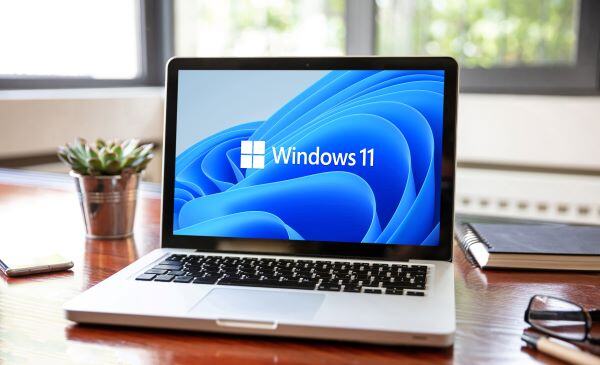 IT spending choices directly impact your bottom line, with cloud solutions offering clear ways to control costs while building capabilities. Your technology investments - from email systems to cybersecurity tools - keep your company competitive without creating budget surprises. I recall a conversation I had with a client years ago - a local business owner with about 25 employees - he said; "Ann, I just need all my tech to work, and at a reasonable price". A lot has changed over the years - tech is so much more pervasive everywhere, and managing cyber risk is now a big part of it. But the bottom line is the same: IT spending choices directly impact your bottom line.
IT spending choices directly impact your bottom line, with cloud solutions offering clear ways to control costs while building capabilities. Your technology investments - from email systems to cybersecurity tools - keep your company competitive without creating budget surprises. I recall a conversation I had with a client years ago - a local business owner with about 25 employees - he said; "Ann, I just need all my tech to work, and at a reasonable price". A lot has changed over the years - tech is so much more pervasive everywhere, and managing cyber risk is now a big part of it. But the bottom line is the same: IT spending choices directly impact your bottom line.
Smart planning helps you evaluate which systems belong in the cloud and implement cost-effective managed services. The right protection strategies shield your business from expensive cyber threats while maintaining predictable monthly expenses. This guide shows you proven methods to get the most value from your technology budget.
1. Cloud Solutions: A Strategic IT Management Approach
As you evaluate your IT program, consider which pieces can be moved to the cloud to save on IT spending and control growing tech costs.
The Evolution of Email Management
Think back to when Ekaru started 20 years ago. Many local small businesses still ran Microsoft Exchange servers in-house, managing their own email. These servers required a lot of maintenance, needed to be replaced every few years, and had enormous, expensive security concerns. Over the years, the first adoption of the cloud has been moving email to the cloud. Microsoft 365 is extremely popular within the business space, and we haven't seen an in-house Exchange server for many years. The idea is to allow the experts to run the infrastructure in the cloud while you consume what you actually need, like a utility bill. You pay based on consumption, such as how many email licenses you need and how big your mailboxes need to be. This month we're working with a local engineering company to move all their files to the Microsoft Cloud, eliminating their local physical file server.
The Rise of Software as a Service (SaaS)
More and more applications are moving to a software as a service (SaaS) model. Take Salesforce, for instance, which is extremely popular for customer relationship management. It runs entirely in the cloud. In the past, you might have run something like this on an in-house server, but now you run it through the cloud and pay the license fees. The big question when talking to people about the cloud, which basically means your hardware is somewhere else and you're connecting to it through the internet, is whether you have any line of business applications that need to be installed locally. Hosting the full application in the cloud can be very expensive, which is why we're seeing small businesses opt more for SaaS with a monthly subscription fee, where you get a username and password and use the application there, rather than lifting entire workloads into the cloud.
Over the years, it's been fascinating to watch these changes. The key is to think through which line of business applications are critical to your company.
Keeping an Eye on Shadow IT
As you evaluate your critical applications, one of the things we want to look at is what's known as shadow IT. We work with clients to evaluate all the cloud applications their team is using because sometimes the marketing department might go out and get an application that has security implications or redundant licenses. You always want to keep tabs on the inventory of all the different applications you use.
The Importance of Regular Updates
With cloud software subscriptions, your subscription fee pays for all the necessary security updates over time. You might be wondering, "Why do we keep having to do these updates?" Well, within cybersecurity, vulnerabilities are identified, and all software has vulnerabilities, not just Microsoft PCs but also Chrome, iPhone, Adobe, and everything you use. These constantly need to be updated, but now you can do this through the updates available from the vendor without having a technician come on-site to help install or download them, making it much easier to manage.
Strategic IT Management
The goal is to strategically implement technology that will help your business grow while keeping a close eye on IT spending. This is a conversation where a company like Ekaru can help you look at all your options and determine where it's strategic to move to the cloud. For some applications, running the line of business application on a local server might make sense for your business because, in general, running applications in the cloud can become very expensive.
It really boils down to strategic IT management. When I talk to a local business, I want to understand what they want to accomplish with the technology they're implementing. What we do isn't just repairing things that are broken, although that is a component. The real magic happens when you can clearly work with a business to understand how to use IT strategically. Then you can strategically manage IT spending, control growing tech costs, and be very strategic about IT management.
2. Smart IT Spending Through Regular Audits
Conducting regular IT audits is essential for controlling growing tech costs and ensuring strategic IT management. When you work with a managed service provider, they should send out monthly reports detailing the hardware and software licenses in use across your organization. Inventory sounds like such a simple concept, but it's the foundation of the NIST Cybersecurity Framework, in addition to being vitally important to controlling costs.
Audit Cloud Applications
Pay special attention to cloud applications, as employees may try out new solutions that don't provide real business benefits or overlap with existing applications. These unused or duplicate services can lead to wasted spending.
Strategic Technology Investments
While it's natural to be concerned about rising technology costs, the key is to apply technology strategically. The right tools will boost productivity and enable your business to accomplish more.
Consider these opportunities:
- Eliminate unused software subscriptions
- Optimize licensing
- Consolidate duplicate services
Optimize Microsoft 365 Licensing
A really simple example of how to save on Microsoft licensing is when an employee leaves the company, convert their Microsoft 365 mailbox into a shared mailbox. This allows you to maintain access to important emails without paying for a full license.
Another consideration is whether to make an annual or monthly commitment with Microsoft. Annual commitments offer cost savings but less flexibility if your team size fluctuates. Monthly commitments through a Microsoft partner provide more agility, which may be worth the slightly higher price for many small businesses.
Maintain Spare Systems and Conference Room Devices
Keep spare systems and conference room devices updated with the latest security patches so they're ready to go when needed. Analyze usage patterns to identify technologies that aren't delivering strategic value and consider replacing them with more effective solutions.
Justify Technology Investments
Remember, while technology spending may be increasing, the returns can be substantial when investments are made strategically. Modern IT solutions offer tremendous benefits that can justify the costs, just as typewriters gave way to more efficient tools.

Plan for Windows 11 Transition
As you plan for the future, be aware that Microsoft will end support for Windows 10 in October 2025. Many systems can be upgraded to Windows 11 in place, but others may require new hardware.
Work with your IT partner to:
- Assess your devices
- Develop a phased replacement plan to avoid budget spikes
With proactive planning, you can smoothly transition to Windows 11 and keep your business running efficiently.
https://www.ekaru.com/products-services/cybersecurity
3. Controlling Growing Tech Costs with Managed Services
For local businesses, even those working with a full-service managed IT provider that handles everything, hiring in-house IT staff usually doesn’t make sense unless the company has at least 100 employees.
The Benefits of Managed Services
The reason is they're probably not going to have enough to do full-time or they're not going to have the right expertise. Maybe they know a lot about PC help desk kind of stuff but they don't know a lot about how to migrate an application into the cloud or how to secure a firewall.
That's really the benefit of working with managed services like what Ekaru does:
- You get a team of people who bring a full depth of expertise to the company
- This includes everything from higher level strategic security planning, doing the business management, looking at the IT spending, doing all that reporting and working with the leadership of the company
- It's about being really strategic with IT management
Predictable Monthly Expenses
Our typical way of working with folks is we just have a fixed monthly fee. We base that on pooling everything that we do with all the clients that we work with. This is what we expect on average to be spending with a company.
It's almost like being in an insurance pool where you're paying for a fraction of everybody. If you're unlucky in one month and there's just a lot going on, you don't get that awful unexpected budget spike. And occasionally you will need some emergency support coverage. Basically everything is in a predictable monthly expense and then you have access to a very wide range of technical expertise that you wouldn't get if you hired just one person.
Specialized Expertise
For example, on our own team, we have one team member who is really in-depth interested in firewalls - all the security features around that, how to implement them, how to optimize them for performance. If you have a phone system and you're looking at your data optimization, how do you secure it? How do you provide secure remote access?
We have another team member who is really into wireless networking as well - how do you position your wireless access points to get the best coverage? In terms of controlling growing tech costs, you want to optimize and get as few access points as you need, but you want to make sure you have great WiFi coverage throughout.
And then there's all the monitoring capabilities, looking at things like if a hard drive is about to get full or a power supply for a system is down. This is all done through monitoring - we don't walk around and actually have to log into each system. There are really great efficiencies and cost savings in doing that and being able to use the smart advanced tools for it.

Migrating to the Cloud
A lot of the work we do these days is moving people from maybe a more traditional in-office file server where everybody would store the common files into Microsoft 365 SharePoint. There's a lot of change involved in that and not all of it is technical. Some of it is people who are used to doing it a certain way and don't understand how to do it the other way.
We'll typically go on site and work with folks one-on-one. We've done town hall training sessions, as an example. Consider a group that we worked with recently that moved off of the Google G Suite to the Microsoft 365 environment. We ran a workshop where we showed them how to do functions in the new system compared to the old one - literally side by side so they could gain a comfort level that they already knew how to do a lot.
By going through this kind of town hall workshop, we were able to show them that everything they were able to do before, they can do in this new environment, and here's how to do it. Don't be intimidated by it and we're here to help. Submit a support ticket and we can do a screen share with you.
But that's another piece that needs to be placed into strategic IT management - how do you manage that change with the people side of the business and get people to understand that when you had your file server in-house and now, especially post COVID, people are working remotely, it's not efficient and you don't get the best performance if everybody has to connect into one physical server. It's a lot more efficient when you can work in the cloud, but people will have to learn how to do that.
Onboarding New Employees
How do you onboard a new employee with new tech? We worked with one business in the area that was adding a lot of people throughout the course of the year. They've typically brought in new people on Mondays. We'd set up a time to walk them through getting set up so they could be productive. Another case is we ship a laptop to another location and walk through with the user how to get set up.
There are a lot of different moving parts, but being able to be proactive and take care of a little problem before it becomes a really big problem is a key part of that. And that's being strategic with IT management.

4. IT Spending Protection Through Cybersecurity
As a small business owner, you may watch the news and see major companies like MGM and UnitedHealthcare falling victim to cyber attacks. This can create a false sense of security, leading you to believe that your 20-person company in a small town is not a target. However, cybercriminals do not discriminate based on the size of your business. They are interested in how much your data is worth to you, and a local small business can be wiped out by a cybersecurity event.
The Importance of Cybersecurity Protection
At Ekaru, one of our primary focus areas in controlling IT spending is protection through cybersecurity. Consider this real-life scenario: we were called in to help a 30-person firm that had experienced a full ransomware event months earlier. They wisely decided to step up their security and reached out to us. We implemented additional security measures, but the incident had already taken a significant financial toll. The company's backup had been wiped away by the scammers, and although they had cyber insurance, which we advise all local businesses to carry, the out-of-pocket expenses still amounted to several hundred thousand dollars.
To manage your IT spending and control growing tech costs, you need to be strategic about your IT management. Small investments in security can potentially offset a giant financial impact that could wipe out your business.
Essential Security Measures
- Implement the right business-class firewall, endpoint protection, and email security system. It is estimated that 90% of threats come in through email, so implementing gateway and mailbox security measures is crucial.
- Conduct security awareness training. We run a platform program for security awareness training so that companies can track it and show it if they are ever audited by insurance. Even if you cannot afford a formal program, having meetings with your team to discuss the latest scams can be highly effective. When people know what the latest scams are, they are far less likely to click on malicious links.
- Be mindful of data handling, especially with the rise of AI tools like ChatGPT. While these tools can be a huge productivity boost for businesses, they also pose a giant security risk if employees input protected information. Employee training and making cybersecurity part of your company culture is crucial in mitigating these risks.
5. Proactive Risk Assessment and Vulnerability Scanning
Risk assessment strategies and vulnerability scanning are also important. We run scans to look for patches that are not up to date so that we can address them proactively. Even in some of the biggest headline cybersecurity incidents involving major Fortune 500 companies, the root cause often boils down to basic cybersecurity failures.
These attacks are not always sophisticated. In many cases, they involve tricking someone into thinking they are getting a call from the help desk or clicking on a malicious pop-up. Educating your employees and making them aware of these scams can go a long way in preventing incidents.
The Value of Proactive Software
We recently had a client whose system was automatically isolated by our proactive software due to a cyber event. The user was unaware of the incident, but our software scanned for certain things and detected the threat. Upon talking to the user, we discovered that they had responded to a phishing attempt two weeks earlier and divulged sensitive information.
Here's the good news: for the price of one latte per month, their system was immediately isolated as soon as a bad actor tried to take action. This small investment could have saved them hundreds of thousands of dollars and even prevented a business wipeout event.
The Importance of Backup and Disaster Recovery
Cyber threats are increasing, and cybercriminals are constantly figuring out new angles. While you may feel like you have to keep spending more on cybersecurity, strategic spending can greatly reduce your risk of having a cyber event or minimize the blast radius of an incident.
Backing up data is also crucial, but not all backup methods are created equal. A simple backup to a hard drive attached to a system puts you at a huge amount of risk. Full backup and disaster recovery with immutable backups and multiple copies in the cloud can make you much safer. While this may cost more upfront, the expenses of incident response, even with cyber insurance, can be extremely high.
At Ekaru, we do a lot of work on education to help people understand the big picture when it comes to cybersecurity and IT spending. By being strategic about your IT management and making smart investments in protection, you can safeguard your business from potentially devastating cybersecurity events.
https://www.ekaru.com/strategy-and-planning-services
Partnering for Smarter IT Cost Management and Growth
Your business deserves a technology partner who knows how to balance costs with growth opportunities. Our team builds clear IT roadmaps that match your goals and budget requirements. Through regular check-ins and active system monitoring, we guide your technology decisions toward measurable outcomes.
Let's review your IT priorities and build a plan that strengthens your competitive position.
Contact us today for a free technology assessment to see how we can help you get more value from every IT dollar spent.
About the author:
Ann Westerheim, PhD is the Founder and President of Ekaru, a Technology Service Provider of cybersecurity and IT services for small and medium businesses in the greater Boston area. Ann is an accomplished technology innovator and leader with three engineering degrees from MIT. She has twenty years of high tech experience in research, advanced development, product development, and as an entrepreneur. Her career has spanned a vast range of technology endeavors including research in thin film semiconductors and superconductors, microprocessor fabrication, development of early Internet medical applications, and now focusing on the application of technology in business. She has an avid focus on the "last mile" of technology and decreasing the digital divide.
.png)
